Submitted:
05 August 2024
Posted:
06 August 2024
You are already at the latest version
Abstract
Keywords:
1. Introduction
2. Data
2.1. (Near-Real-Time) Climate Data Record Sea Ice Concentration
2.2. Merged MODIS-AMSR2 Sea Ice Concentration
2.3. Coastal Sea Ice Radar System Images
3. Methods
3.1. Floe Edge Detection Algorithms
3.2. Post-Processing
3.3. Parameters Optimization
3.4. CSIRS Daily SIC Product
3.5. Comparison of SIC Products
4. Results
4.1. Optimization/Validation
4.2. CSIRS Reconstructed Sea Ice Concentration
4.2.1. Daily SIC
5. Discussion and Conclusions
Author Contributions
Funding
Data Availability Statement
Acknowledgments
Conflicts of Interest
References
- Stroeve, J.C.; Markus, T.; Boisvert, L.; Miller, J.; Barrett, A. Changes in Arctic melt season and implications for sea ice loss. Geophysical Research Letters 2014, 41, 1216–1225, _eprint: https://onlinelibrary.wiley.com/doi/pdf/10.1002/2013GL058951. [Google Scholar] [CrossRef]
- Ford, J.D.; Willox, A.C.; Chatwood, S.; Furgal, C.; Harper, S.; Mauro, I.; Pearce, T. Adapting to the Effects of Climate Change on Inuit Health. American Journal of Public Health 2014, 104, e9–e17. [Google Scholar] [CrossRef] [PubMed]
- Post, E.; Alley, R.B.; Christensen, T.R.; Macias-Fauria, M.; Forbes, B.C.; Gooseff, M.N.; Iler, A.; Kerby, J.T.; Laidre, K.L.; Mann, M.E.; Olofsson, J.; Stroeve, J.C.; Ulmer, F.; Virginia, R.A.; Wang, M. The polar regions in a 2°C warmer world. Science Advances 2019, 5, eaaw9883. [Google Scholar] [CrossRef] [PubMed]
- Box, J.E.; Colgan, W.T.; Christensen, T.R.; Schmidt, N.M.; Lund, M.; Parmentier, F.J.W.; Brown, R.; Bhatt, U.S.; Euskirchen, E.S.; Romanovsky, V.E.; Walsh, J.E.; Overland, J.E.; Wang, M.; Corell, R.W.; Meier, W.N.; Wouters, B.; Mernild, S.; Mård, J.; Pawlak, J.; Olsen, M.S. Key indicators of Arctic climate change: 1971–2017. Environmental Research Letters 2019, 14, 045010. [Google Scholar] [CrossRef]
- Middleton, J.; Cunsolo, A.; Jones-Bitton, A.; Wright, C.J.; Harper, S.L. Indigenous mental health in a changing climate: a systematic scoping review of the global literature. Environmental Research Letters 2020, 15, 053001. [Google Scholar] [CrossRef]
- Middleton, J.; Cunsolo, A.; Jones-Bitton, A.; Shiwak, I.; Wood, M.; Pollock, N.; Flowers, C.; Harper, S.L. “We’re people of the snow:” Weather, climate change, and Inuit mental wellness. Social Science & Medicine 2020, 262, 113137. [Google Scholar] [CrossRef]
- Meier, W.; Stroeve, J. An Updated Assessment of the Changing Arctic Sea Ice Cover. Oceanography 2022. [Google Scholar] [CrossRef]
- Schuur, E.A.; Abbott, B.W.; Commane, R.; Ernakovich, J.; Euskirchen, E.; Hugelius, G.; Grosse, G.; Jones, M.; Koven, C.; Leshyk, V.; Lawrence, D.; Loranty, M.M.; Mauritz, M.; Olefeldt, D.; Natali, S.; Rodenhizer, H.; Salmon, V.; Schädel, C.; Strauss, J.; Treat, C.; Turetsky, M. Permafrost and Climate Change: Carbon Cycle Feedbacks From the Warming Arctic. Annual Review of Environment and Resources 2022, 47, 343–371. [Google Scholar] [CrossRef]
- Stroeve, J.; Notz, D. Changing state of Arctic sea ice across all seasons. Environmental Research Letters 2018, 13, 103001, Publisher: IOP Publishing. [Google Scholar] [CrossRef]
- Nghiem, S.V.; Rigor, I.G.; Perovich, D.K.; Clemente-Colón, P.; Weatherly, J.W.; Neumann, G. Rapid reduction of Arctic perennial sea ice. Geophysical Research Letters 2007, 34. _eprint: https://onlinelibrary.wiley.com/doi/pdf/10.1029/2007GL031138. [Google Scholar] [CrossRef]
- Comiso, J.C. Large Decadal Decline of the Arctic Multiyear Ice Cover. Journal of Climate 2012, 25, 1176–1193, Publisher: American Meteorological Society Section: Journal of Climate. [Google Scholar] [CrossRef]
- Ford, J.D.; Pearce, T.; Canosa, I.V.; Harper, S. The rapidly changing Arctic and its societal implications. WIREs Climate Change 2021, 12, e735, _eprint: https://onlinelibrary.wiley.com/doi/pdf/10.1002/wcc.735. [Google Scholar] [CrossRef]
- Hauser, D.D.W.; Whiting, A.V.; Mahoney, A.R.; Goodwin, J.; Harris, C.; Schaeffer, R.J.; Schaeffer, R.; Laxague, N.J.M.; Subramaniam, A.; Witte, C.R.; Betcher, S.; Lindsay, J.M.; Zappa, C.J. Co-production of knowledge reveals loss of Indigenous hunting opportunities in the face of accelerating Arctic climate change. Environmental Research Letters 2021, 16, 095003. [Google Scholar] [CrossRef]
- Ford, J.D. Dangerous climate change and the importance of adaptation for the Arctic’s Inuit population. Environmental Research Letters 2009, 4, 024006. [Google Scholar] [CrossRef]
- Ford, J.D.; Clark, D.; Pearce, T.; Berrang-Ford, L.; Copland, L.; Dawson, J.; New, M.; Harper, S.L. Changing access to ice, land and water in Arctic communities. Nature Climate Change 2019, 9, 335–339, Number: 4 Publisher: Nature Publishing Group. [Google Scholar] [CrossRef]
- Meier, W.; Fetterer, F.; Windnagel, A.; Stewart, S. Near-Real-Time NOAA/NSIDC Climate Data Record of Passive Microwave Sea Ice Concentration, Version 2, 2021. [CrossRef]
- Meier, W.; Fetterer, F.; Windnagel, A.; Stewart, S. NOAA/NSIDC Climate Data Record of Passive Microwave Sea Ice Concentration, Version 4, 2021. [CrossRef]
- Ludwig, V.; Spreen, G.; Pedersen, L.T. Evaluation of a New Merged Sea-Ice Concentration Dataset at 1 km Resolution from Thermal Infrared and Passive Microwave Satellite Data in the Arctic. Remote Sensing 2020, 12, 3183, Number: 19 Publisher: Multidisciplinary Digital Publishing Institute. [Google Scholar] [CrossRef]
- Kern, S.; Lavergne, T.; Notz, D.; Pedersen, L.T.; Tonboe, R. Satellite passive microwave sea-ice concentration data set inter-comparison for Arctic summer conditions. The Cryosphere 2020, 14, 2469–2493. [Google Scholar] [CrossRef]
- Ludwig, V.; Spreen, G.; Haas, C.; Istomina, L.; Kauker, F.; Murashkin, D. The 2018 North Greenland polynya observed by a newly introduced merged optical and passive microwave sea-ice concentration dataset. The Cryosphere 2019, 13, 2051–2073. [Google Scholar] [CrossRef]
- Parkinson, C.L.; Cavalieri, D.J. Arctic sea ice 1973–1987: Seasonal, regional, and interannual variability. Journal of Geophysical Research: Oceans 1989, 94, 14499–14523, _eprint: https://onlinelibrary.wiley.com/doi/pdf/10.1029/JC094iC10p14499. [Google Scholar] [CrossRef]
- Canadian Ice Service. Canadian Ice Service Arctic Regional Sea Ice Charts in SIGRID-3 Format, Version 1 2009. Publisher: NSIDC. [CrossRef]
- Dierking, W. Sea Ice Monitoring by Synthetic Aperture Radar. Oceanography 2013, 26, 100–111, Publisher: Oceanography Society. [Google Scholar] [CrossRef]
- Soh, L.K.; Tsatsoulis, C. Texture analysis of SAR sea ice imagery using gray level co-occurrence matrices. IEEE Transactions on Geoscience and Remote Sensing 1999, 37, 780–795, Conference Name: IEEE Transactions on Geoscience and Remote Sensing. [Google Scholar] [CrossRef]
- Ochilov, S.; Clausi, D.A. Operational SAR Sea-Ice Image Classification. IEEE Transactions on Geoscience and Remote Sensing 2012, 50, 4397–4408, Conference Name: IEEE Transactions on Geoscience and Remote Sensing. [Google Scholar] [CrossRef]
- Shirasawa, K.; Ebuchi, N.; Leppäranta, M.; Takatsuka, T. Ice-edge detection from Japanese C-band radar and high-frequency radar coastal stations. Annals of Glaciology 2013, 54, 59–64, Publisher: Cambridge University Press. [Google Scholar] [CrossRef]
- Nicolaus, M.; Perovich, D.K.; Spreen, G.; Granskog, M.A.; von Albedyll, L.; Angelopoulos, M.; Anhaus, P.; Arndt, S.; Belter, H.J.; Bessonov, V.; Birnbaum, G.; Brauchle, J.; Calmer, R.; Cardellach, E.; Cheng, B.; Clemens-Sewall, D.; Dadic, R.; Damm, E.; de Boer, G.; Demir, O.; Dethloff, K.; Divine, D.V.; Fong, A.A.; Fons, S.; Frey, M.M.; Fuchs, N.; Gabarró, C.; Gerland, S.; Goessling, H.F.; Gradinger, R.; Haapala, J.; Haas, C.; Hamilton, J.; Hannula, H.R.; Hendricks, S.; Herber, A.; Heuzé, C.; Hoppmann, M.; Høyland, K.V.; Huntemann, M.; Hutchings, J.K.; Hwang, B.; Itkin, P.; Jacobi, H.W.; Jaggi, M.; Jutila, A.; Kaleschke, L.; Katlein, C.; Kolabutin, N.; Krampe, D.; Kristensen, S.S.; Krumpen, T.; Kurtz, N.; Lampert, A.; Lange, B.A.; Lei, R.; Light, B.; Linhardt, F.; Liston, G.E.; Loose, B.; Macfarlane, A.R.; Mahmud, M.; Matero, I.O.; Maus, S.; Morgenstern, A.; Naderpour, R.; Nandan, V.; Niubom, A.; Oggier, M.; Oppelt, N.; Pätzold, F.; Perron, C.; Petrovsky, T.; Pirazzini, R.; Polashenski, C.; Rabe, B.; Raphael, I.A.; Regnery, J.; Rex, M.; Ricker, R.; Riemann-Campe, K.; Rinke, A.; Rohde, J.; Salganik, E.; Scharien, R.K.; Schiller, M.; Schneebeli, M.; Semmling, M.; Shimanchuk, E.; Shupe, M.D.; Smith, M.M.; Smolyanitsky, V.; Sokolov, V.; Stanton, T.; Stroeve, J.; Thielke, L.; Timofeeva, A.; Tonboe, R.T.; Tavri, A.; Tsamados, M.; Wagner, D.N.; Watkins, D.; Webster, M.; Wendisch, M. Overview of the MOSAiC expedition: Snow and sea ice. Elementa: Science of the Anthropocene 2022, 10, 000046. [Google Scholar] [CrossRef]
- Tabata, T. Sea-ice Reconnaissance by Radar. Journal of Glaciology 1975, 15, 215–224, Publisher: Cambridge University Press. [Google Scholar] [CrossRef]
- Mv, R.; Jones, J.; Eicken, H.; Kambhamettu, C. Extracting Quantitative Information on Coastal Ice Dynamics and Ice Hazard Events From Marine Radar Digital Imagery. IEEE Transactions on Geoscience and Remote Sensing 2013, 51, 2556–2570. [Google Scholar] [CrossRef]
- Karvonen, J. Tracking the motion of recognizable sea-ice objects from coastal radar image sequences. Annals of Glaciology 2013, 54, 41–49, Publisher: Cambridge University Press. [Google Scholar] [CrossRef]
- Karvonen, J. Virtual radar ice buoys – a method for measuring fine-scale sea ice drift. The Cryosphere 2016, 10, 29–42. [Google Scholar] [CrossRef]
- Oikkonen, A.; Haapala, J.; Lensu, M.; Karvonen, J. Sea ice drift and deformation in the coastal boundary zone. Geophysical Research Letters 2016, 43, 10,303–10,310, _eprint: https://onlinelibrary.wiley.com/doi/pdf/10.1002/2016GL069632. [Google Scholar] [CrossRef]
- Lund, B.; Graber, H.C.; Persson, P.O.G.; Smith, M.; Doble, M.; Thomson, J.; Wadhams, P. Arctic Sea Ice Drift Measured by Shipboard Marine Radar. Journal of Geophysical Research: Oceans 2018, 123, 4298–4321, _eprint: https://onlinelibrary.wiley.com/doi/pdf/10.1029/2018JC013769. [Google Scholar] [CrossRef]
- Flock, W.L. Monitoring Open Water and Sea Ice in the Bering Strait by Radar. IEEE Transactions on Geoscience Electronics 1977, 15, 196–202, Conference Name: IEEE Transactions on Geoscience Electronics. [Google Scholar] [CrossRef]
- Haykin, S.; Currie, B.; Lewis, E.; Nickerson, K. Surface-based radar imaging of sea ice. Proceedings of the IEEE 1985, 73, 233–251, Conference Name: Proceedings of the IEEE. [Google Scholar] [CrossRef]
- Shapiro, L.H.; Metzner, R.C. Nearshore iceconditions from radar data, Point Barrow, Alaska. Fairbanks: University of Alaska Fairbanks 1989.
- Mahoney, A.; Eicken, H.; Shapiro, L. How fast is landfast sea ice? A study of the attachment and detachment of nearshore ice at Barrow, Alaska. Cold Regions Science and Technology 2007, 47, 233–255. [Google Scholar] [CrossRef]
- Mahoney, A.R.; Eicken, H.; Fukamachi, Y.; Ohshima, K.I.; Simizu, D.; Kambhamettu, C.; Rohith, M.; Hendricks, S.; Jones, J. Taking a look at both sides of the ice: comparison of ice thickness and drift speed as observed from moored, airborne and shore-based instruments near Barrow, Alaska. Annals of Glaciology 2015, 56, 363–372. [Google Scholar] [CrossRef]
- Kettle, N.P.; Abdel-Fattah, D.; Mahoney, A.R.; Eicken, H.; Brigham, L.W.; Jones, J. Linking Arctic system science research to decision maker needs: co-producing sea ice decision support tools in Utqiaġvik, Alaska. Polar Geography 2020, 43, 206–222. [Google Scholar] [CrossRef]
- Cavalieri, D.J.; Gloersen, P.; Campbell, W.J. Determination of sea ice parameters with the NIMBUS 7 SMMR. Journal of Geophysical Research: Atmospheres 1984, 89, 5355–5369. [Google Scholar] [CrossRef]
- Comiso, J.C. Characteristics of Arctic winter sea ice from satellite multispectral microwave observations. Journal of Geophysical Research 1986, 91, 975. [Google Scholar] [CrossRef]
- Druckenmiller, M.L.; Eicken, H.; Johnson, M.A.; Pringle, D.J.; Williams, C.C. Toward an integrated coastal sea-ice observatory: System components and a case study at Barrow, Alaska. Cold Regions Science and Technology 2009, 56, 61–72. [Google Scholar] [CrossRef]
- Canny, J. A Computational Approach to Edge Detection. IEEE Transactions on Pattern Analysis and Machine Intelligence 1986, PAMI-8, 679–698. Conference Name: IEEE Transactions on Pattern Analysis and Machine Intelligence. [CrossRef]
- Bradski, G. The OpenCV Library. Dr. Dobb’s Journal of Software Tools 2000.
- Suzuki, S.; be, K. Topological structural analysis of digitized binary images by border following. Computer Vision, Graphics, and Image Processing 1985, 30, 32–46. [Google Scholar] [CrossRef]
- Bradski, G.R.; Kaehler, A. Learning OpenCV: computer vision with the OpenCV library, 1. ed., [nachdr.] ed.; Software that sees, O’Reilly: Beijing, 2011. [Google Scholar]
- Cheng, A.; Casati, B.; Tivy, A.; Zagon, T.; Lemieux, J.F.; Tremblay, L.B. Accuracy and inter-analyst agreement of visually estimated sea ice concentrations in Canadian Ice Service ice charts using single-polarization RADARSAT-2. The Cryosphere 2020, 14, 1289–1310, Publisher: Copernicus GmbH. [Google Scholar] [CrossRef]
- Parkinson, C.L. Spatial patterns of increases and decreases in the length of the sea ice season in the north polar region, 1979–1986. Journal of Geophysical Research: Oceans 1992, 97, 14377–14388, _eprint: https://onlinelibrary.wiley.com/doi/pdf/10.1029/92JC01367. [Google Scholar] [CrossRef]
- Jones, J.; Eicken, H.; Mahoney, A.; Mv, R.; Kambhamettu, C.; Fukamachi, Y.; Ohshima, K.I.; George, J.C. Landfast sea ice breakouts: Stabilizing ice features, oceanic and atmospheric forcing at Barrow, Alaska. Continental Shelf Research 2016, 126, 50–63. [Google Scholar] [CrossRef]
- Aucoin, S.; Tremblay, B.; Newton, R. Coastal Sea-Ice Break-Up Events in Beringia. McGill Science Undergraduate Research Journal 2022, 17, 18–22, Number: 1. [Google Scholar] [CrossRef]
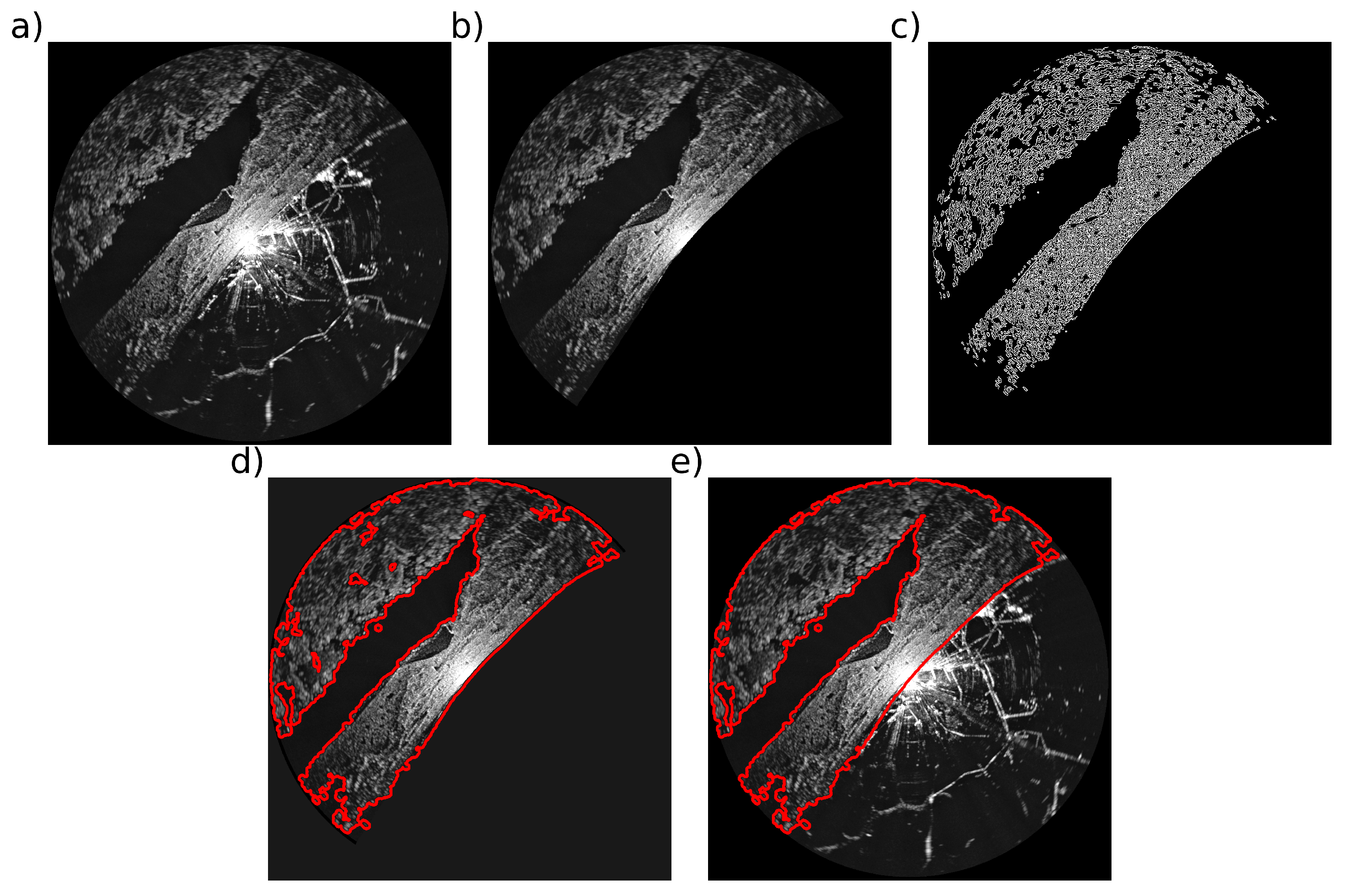
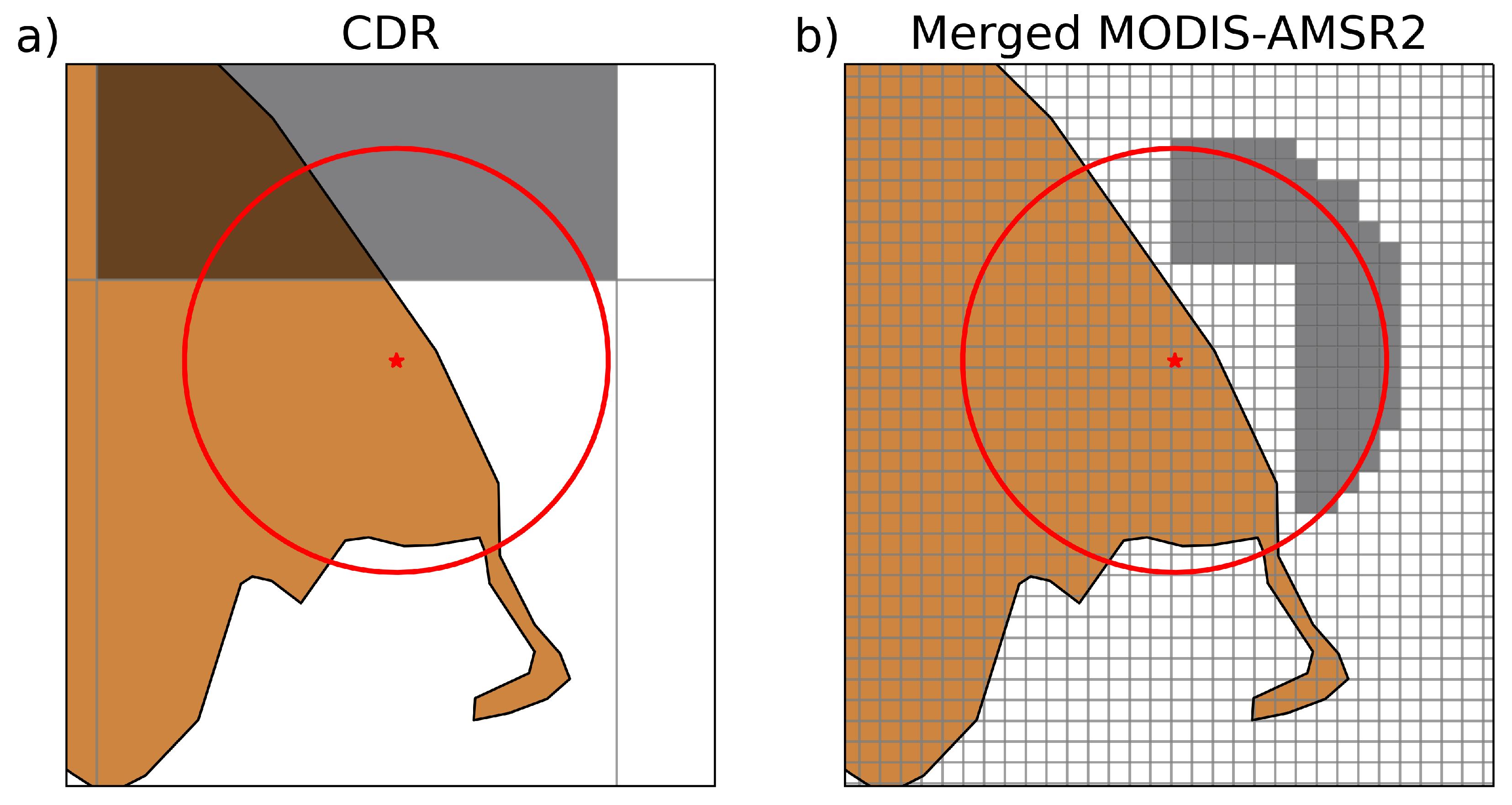
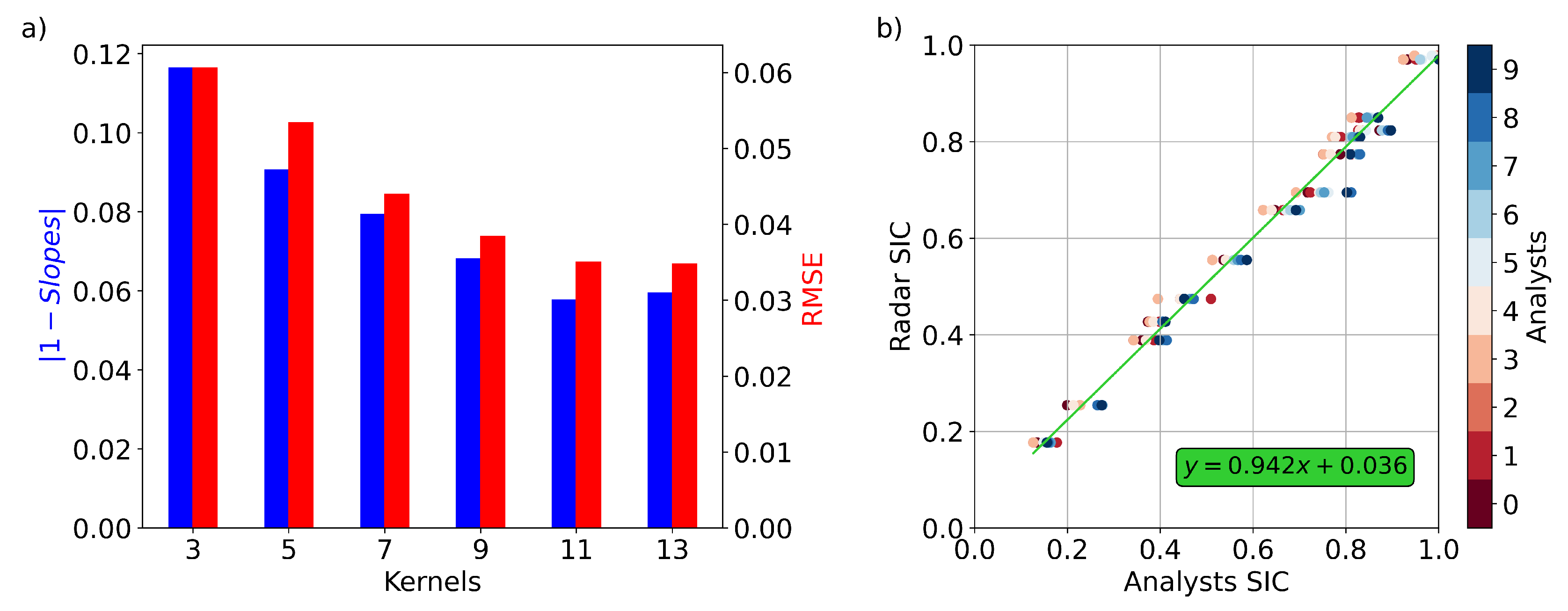
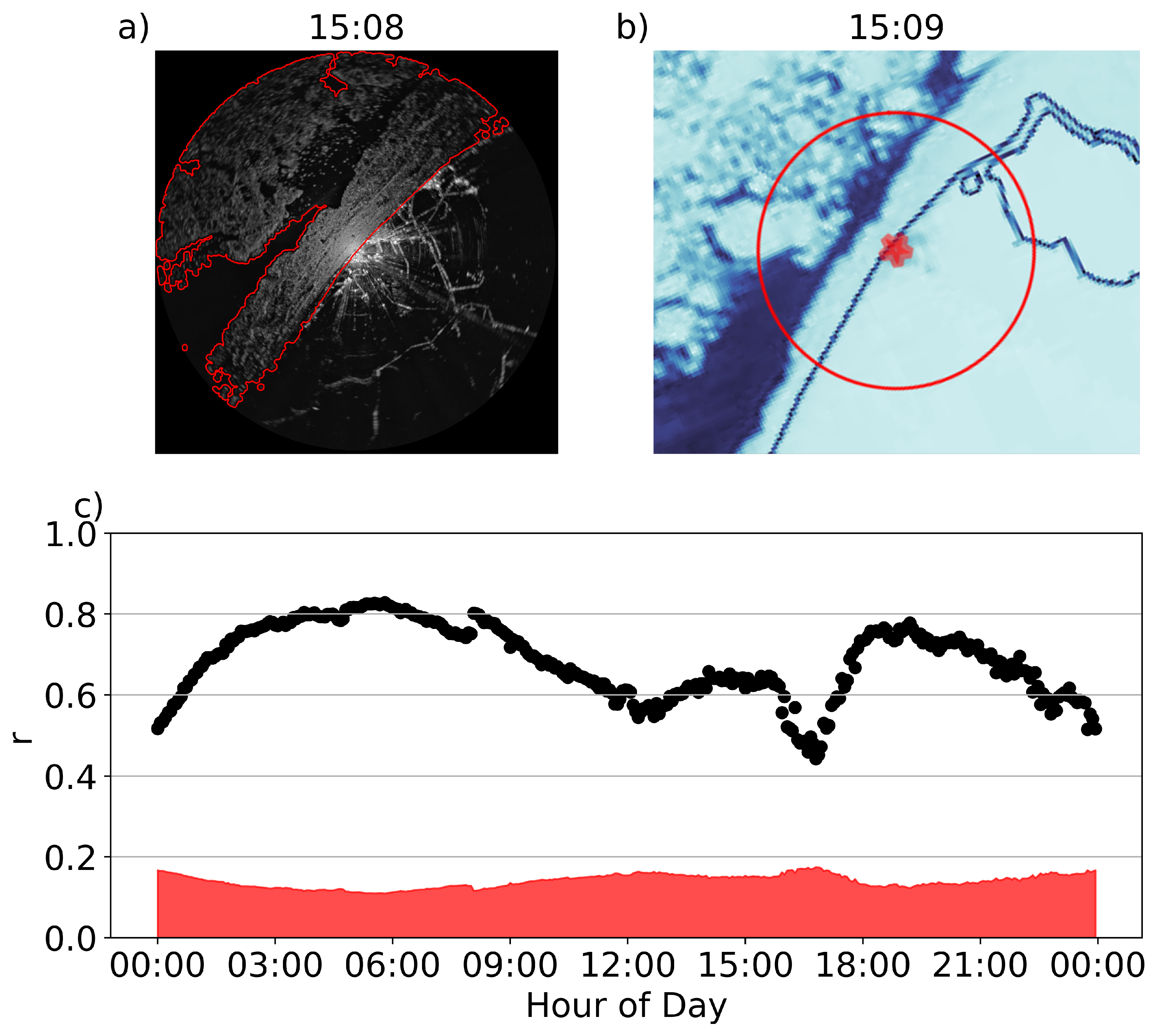
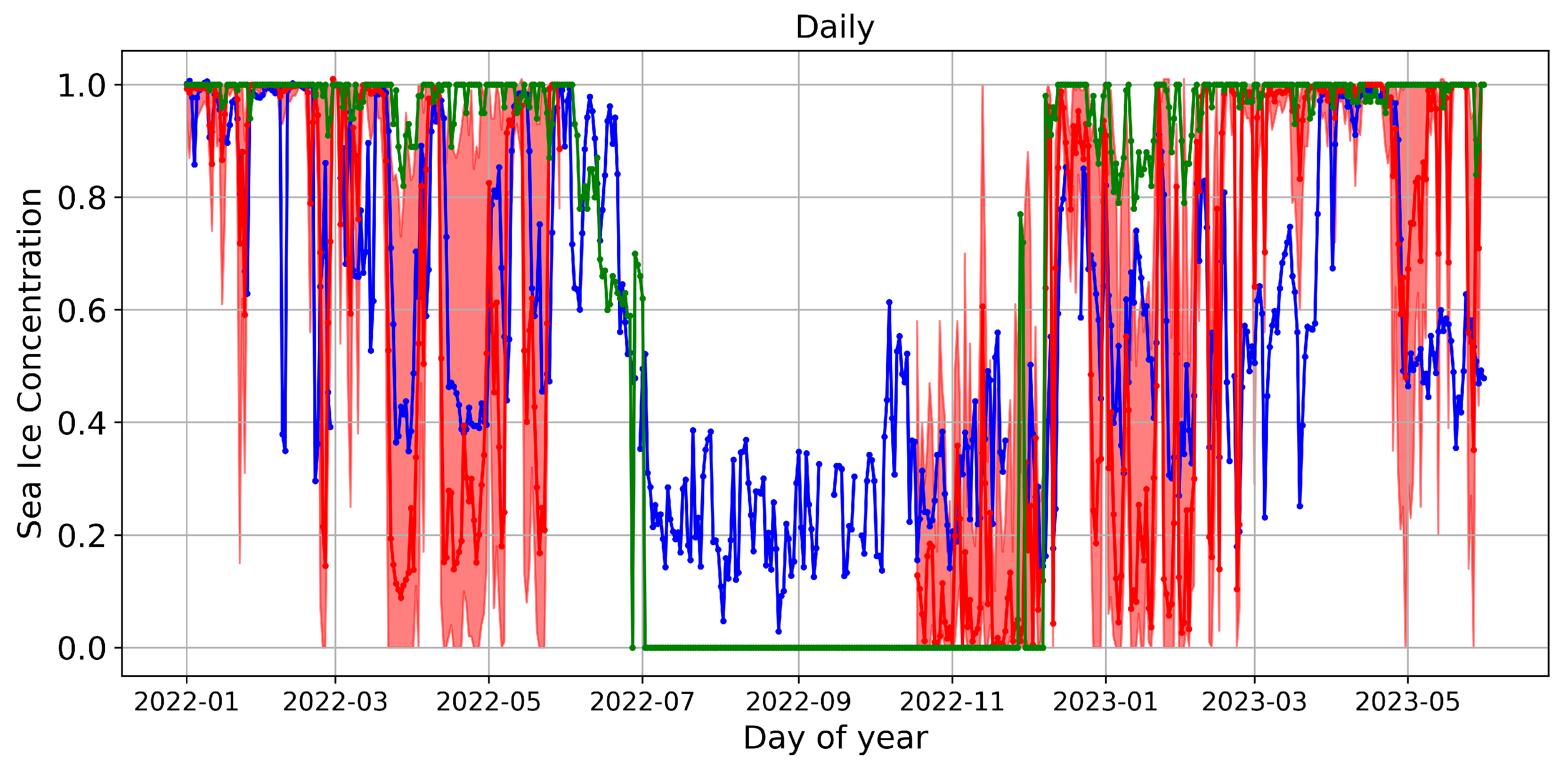
| SIC Type | r | RMSE | MBE | |
|---|---|---|---|---|
| CDR | Daily | 0.18 | 0.34 | -0.010 |
| 7 Days RM | 0.26 | 0.31 | -0.010 | |
| 31 Days RM | 0.71 | 0.28 | -0.010 | |
| merged MODIS-AMSR2 | Daily | 0.54 | 0.29 | - |
| 7 Days RM | 0.68 | 0.23 | - | |
| 31 Days RM | 0.59 | 0.20 |
Disclaimer/Publisher’s Note: The statements, opinions and data contained in all publications are solely those of the individual author(s) and contributor(s) and not of MDPI and/or the editor(s). MDPI and/or the editor(s) disclaim responsibility for any injury to people or property resulting from any ideas, methods, instructions or products referred to in the content. |
© 2024 by the authors. Licensee MDPI, Basel, Switzerland. This article is an open access article distributed under the terms and conditions of the Creative Commons Attribution (CC BY) license (https://creativecommons.org/licenses/by/4.0/).





